Sustainable Nutrient Management Strategies for Enhancing Potato Production: The Role of Cover Crops—A Systematic Review
Abstract
1. Introduction
2. The Role of Cover Cropping System and Its Influence on NUE
3. Cover Cropping on Soil Health/Fertility
4. Role of Cover Cropping on Potato Production
| Cover Crops | Climate Region | Soil Type | Management Goals | References |
|---|---|---|---|---|
| Winter rye | Humid | Sandy soil | Reduce pest diseases, increase soil organic matter, and marketable yield. | [69] |
| Dolichos | Dry sub-humid | Humic Nitisol | Increase NUE, ground cover, soil moisture content, and potato yield. | [37] |
| Vetch | Continental monsoon | Loam | Reduce black scurf, common scab, and silver scurf, increase tuber yield, and water use efficiency. | [71] |
| Rapeseed | Wet temperate | Loam | Reduce black scurf and increase yield. | [72] |
| Pearl millet + sorghum sudangrass + red clover | Dry temperate | sandy loam | Reduce root-lesion nematodes and increase marketable yield. | [73] |
| Hairy vetch + clover + rapeseed + ryegrass | _ | _ | Increase total marketable yield by increasing N available for crops. | [74] |
| Barley, canola, and rapeseed | _ | sandy loam | Suppressed weeds and increased yield. | [26] |
| Indian mustard | _ | Bangor silt loam | Reduced powdery scab (caused by Spongospora subterranea) and common scab (Streptomyces scabies) in potato cropping systems. | [75] |
| Rye + forage + radish and winter pea | _ | sandy loam | Enhancing potato tuber yield. | [68] |
5. Cover Cropping on Economic Viability, and Climate Change Mitigation
| Crop of Interest | Legume/Non Legume Crop | Nitrogen Recovery (%) | Net Surplus (kg/ha) | N Leaching Recovery | CO2 Reduced (%) | Cost Production | Economic Return | References |
|---|---|---|---|---|---|---|---|---|
| Maize | Orchid and hairy vetch mixture | +23 | 197 | _ | −30% | _ | _ | [76] |
| Hairy vetch only | +43 | 112 | ||||||
| February orchid only | +16 | 182 | ||||||
| Common vetch | +74% | |||||||
| Alfalfa | +103% | |||||||
| _ | Sunn hemp + cowpea + sudangrass | - | 280% | −709% | $320–$4364 | _ | [85] | |
| Maize | cereal rye + daikon radish | 57% | _ | 34% | _ | _ | 61% | [80] |
| potato | oat–vetch | _ | _ | _ | US$0.03 and US$0.06 | +24% | [71] | |
| Rice | Winged bean | 15–33% | _ | _ | _ | _ | _ | [86] |
| Bush bean | 20–29% | _ | _ | _ | _ | _ |
6. Limitations of Using Cover Crops on Potatoes
7. Review Methodology
8. Results
8.1. Historical and Current Trend of Scientific Contribution per Document
8.2. Top Countries Contributing the Most Cited Scientific Research on Potato
8.3. Summary of Top Global Most Cited Published Documents
| Rank | Author | DOI | TC | TC/Y |
|---|---|---|---|---|
| 1 | [87] | 10.1016/S1161-0301(02)00107-7 | 3240 | 147.27 |
| 2 | [49] | 10.1016/S0065-2113(05)88004-6 | 972 | 48.60 |
| 3 | [88] | 10.1016/j.soilbio.2006.07.001 | 475 | 26.39 |
| 4 | [89] | 10.1016/j.still.2017.01.001 | 462 | 57.75 |
| 5 | [90] | 10.1111/j.1365-3059.2011.02427.x | 323 | 23.07 |
| 6 | [91] | 10.1080/07352680490433295 | 297 | 14.14 |
| 7 | [92] | 10.1007/s11540-009-9136-3 | 281 | 17.56 |
| 8 | [93] | 10.3390/SU12124859 | 269 | 53.80 |
| 9 | [94] | 10.1163/ej.9789004155640.i-523 | 256 | 14.22 |
| 10 | [95] | 10.1016/j.earscirev.2018.06.013 | 244 | 34.86 |
8.4. Authors’ Key Words and Co-Occurrence Network
Hot Topics
9. Discussion
10. Conclusions
Author Contributions
Funding
Data Availability Statement
Conflicts of Interest
References
- Alexandratos, N.; Bruinsma, J. World Agriculture Towards 2030/2050: The 2012 Revision; Food and Agriculture Organization (FAO): Rome, Italy, 2012. [Google Scholar] [CrossRef]
- Beltran-Peña, A.; Rosa, L.; D’Odorico, P. Global food self-sufficiency in the 21st century under sustainable intensification of agriculture. Environ. Res. Lett. 2020, 15, 095004. [Google Scholar] [CrossRef]
- Kumar, P.; Kumar, P.; Sharma, D.; Verma, S.K.; Halterman, D.; Kumar, A. Genome-wide identification and expression profiling of basic leucine zipper transcription factors following abiotic stresses in potato (Solanum tuberosum L.). PLoS ONE 2021, 16, e0247864. [Google Scholar] [CrossRef]
- Gaj, R.; Murawska, B.; Fabisiak-Spychaj, E.; Budka, A.; Kozera, W. The impact of cover crops and foliar application of micronutrients on accumulation of macronutrients in potato tubers at technological maturity stage. Eur. J. Hortic. Sci. 2018, 83, 345–355. [Google Scholar] [CrossRef]
- Zhang, H.; Ghahramani, A.; Ali, A.; Erbacher, A. Cover cropping impacts on soil water and carbon in dryland cropping systems. PLoS ONE 2023, 18, e0286748. [Google Scholar] [CrossRef] [PubMed]
- Milroy, S.P.; Wang, P.; Sadras, V.O. Defining upper limits of nitrogen uptake and nitrogen use efficiency of potato in response to crop N supply. Field Crops Res. 2019, 239, 38–46. [Google Scholar] [CrossRef]
- Goulding, K.; Jarvis, S.; Whitmore, A. Optimizing nutrient management for farm systems. Philos. Trans. R. Soc. B Biol. Sci. 2008, 363, 667–680. [Google Scholar] [CrossRef]
- Wu, Y.; Xu, M.; Wang, X.; Zhuang, M. Towards sustainable potato production through optimal nutrient management in China. Int. J. Life Cycle Assess. 2025, 1–13. [Google Scholar] [CrossRef]
- Dawadi, S.; Baysal-Gurel, F.; Addesso, K.M.; Oliver, J.B.; Simmons, T. Impact of cover crop usage on soilborne diseases in field nursery production. Agronomy 2019, 9, 753. [Google Scholar] [CrossRef]
- Kirwan, L.; Connolly, J.; Finn, J.A.; Brophy, C.; Lüscher, A.; Nyfeler, D.; Sebastià, M.T. Diversity–interaction modeling: Estimating contributions of species identities and interactions to ecosystem function. Ecology 2009, 90, 2032–2038. [Google Scholar] [CrossRef]
- Nyfeler, D.; Huguenin-Elie, O.; Suter, M.; Frossard, E.; Lüscher, A. Grass–legume mixtures can yield more nitrogen than legume pure stands due to mutual stimulation of nitrogen uptake from symbiotic and non-symbiotic sources. Agric. Ecosyst. Environ. 2011, 140, 155–163. [Google Scholar] [CrossRef]
- Neeteson, J.J. Effect of legumes on soil mineral nitrogen and response of potatoes to nitrogen fertiliser. In Effects of Crop Rotation on Potato Production in the Temperate Zones, Proceedings of the International Conference on Effects of Crop Rotation on Potato Production in the Temperate Zones, Wageningen, The Netherlands, 14–19 August 1988; Springer: Dordrecht, The Netherlands, 1989; pp. 89–93. [Google Scholar] [CrossRef]
- Malik, R.K.; Green, T.H.; Brown, G.F.; Mays, D. Use of cover crops in short-rotation hardwood plantations to control erosion. Biomass Bioenergy 2000, 18, 479–487. [Google Scholar] [CrossRef]
- Monteiro, A.; Lopes, C.M. Influence of cover crop on water use and performance of vineyard in Mediterranean Portugal. Agric. Ecosyst. Environ. 2007, 121, 336–342. [Google Scholar] [CrossRef]
- Delgado, J.A.; Li, R. The Nanchang communication about the potential for implementation of conservation practices for climate change mitigation and adaptation to achieve food security in the 21st century. Int. Soil Water Conserv. Res. 2016, 4, 148–150. [Google Scholar] [CrossRef]
- Somenahally, A.; DuPont, J.I.; Brady, J.; McLawrence, J.; Northup, B.; Gowda, P. Microbial communities in the soil profile are more responsive to legacy effects of wheat-cover crop rotations than tillage systems. Soil Biol. Biochem. 2018, 123, 126–135. [Google Scholar] [CrossRef]
- Saliu, F.; Luqman, M.; Alkhaz’leh, H.S. A review on the impact of sustainable agriculture practices on crop yields and soil health. Int. J. Res. Adv. Agric. Sci. 2023, 2, 1–13. [Google Scholar]
- Alletto, L.; Cassigneul, A.; Duchalais, A.; Giuliano, S.; Brechemier, J.; Justes, E. Cover crops maintain or improve the agronomic performance of maize monoculture during the transition period from conventional to no-tillage. Field Crops Res. 2022, 283, 108540. [Google Scholar] [CrossRef]
- Sanabria Quispe, S.; Mendoza Dávalos, K.; Sangay-Tucto, S.; Cosme De La Cruz, R.C. Use of cover crops for sustainable soil management associated with corn (Zea mays L.) cultivation. Sci. Agropecu. 2021, 12, 329–336. [Google Scholar] [CrossRef]
- Qin, Z.; Guan, K.; Zhou, W.; Peng, B.; Villamil, M.B.; Jin, Z.; Tang, J.; Grant, R.; Gentry, L.; Margenot, A.J.; et al. Assessing the impacts of cover crops on maize and soybean yield in the US Midwestern agroecosystems. Field Crops Res. 2021, 273, 108264. [Google Scholar] [CrossRef]
- Dunn, M.; Ulrich-Schad, J.D.; Prokopy, L.S.; Myers, R.L.; Watts, C.R.; Scanlon, K. Perceptions and use of cover crops among early adopters: Findings from a national survey. J. Soil Water Conserv. 2016, 71, 29–40. [Google Scholar] [CrossRef]
- Scholberg, J.M.; Dogliotti, S.; Zotarelli, L.; Cherr, C.M.; Leoni, C.; Rossing, W.A. Cover crops in agrosystems: Innovations and applications. In Genetic Engineering, Biofertilisation, Soil Quality and Organic Farming; Springer: Dordrecht, The Netherlands, 2010; pp. 59–97. [Google Scholar] [CrossRef]
- Van Eerd, L.L.; Chahal, I.; Peng, Y.; Awrey, J.C. Influence of cover crops at the four spheres: A review of ecosystem services, potential barriers, and future directions for North America. Sci. Total Environ. 2023, 858, 159990. [Google Scholar] [CrossRef]
- Koudahe, K.; Allen, S.C.; Djaman, K. Critical review of the impact of cover crops on soil properties. Int. Soil Water Conserv. Res. 2022, 10, 343–354. [Google Scholar] [CrossRef]
- Bilek, M.K. Winter Annual Rye Cover Crops in No-Till Grain Crop Rotations: Impacts on Soil Physical Properties and Organic Matter. Master’s Thesis, University of Maryland, College Park, MD, USA, 2007. [Google Scholar]
- Wortman, S.E.; Francis, C.A.; Bernards, M.L.; Drijber, R.A.; Lindquist, J.L. Optimizing cover crop benefits with diverse mixtures and an alternative termination method. Agron. J. 2012, 104, 1425–1435. [Google Scholar] [CrossRef]
- Adetunji, A.T.; Ncube, B.; Meyer, A.H.; Olatunji, O.S.; Mulidzi, R.; Lewu, F.B. Soil pH, nitrogen, phosphatase, and urease activities in response to cover crop species, termination stage, and termination method. Heliyon 2021, 7, e05980. [Google Scholar] [CrossRef] [PubMed]
- Shah, F.; Wu, W. Soil and crop management strategies to ensure higher crop productivity within sustainable environments. Sustainability 2019, 11, 1485. [Google Scholar] [CrossRef]
- Baldantoni, D.; Bellino, A.; Cicatelli, A.; Castiglione, S. Influence of the Choice of Cultivar and Soil Fertilization on PTE Concentrations in Lactuca sativa L. in the Framework of the Regenerative Agriculture Revolution. Land 2021, 10, 1053. [Google Scholar] [CrossRef]
- Muhie, S.H. Novel approaches and practices to sustainable agriculture. J. Agric. Food Res. 2022, 10, 100446. [Google Scholar] [CrossRef]
- Jolaini, M.; Karimi, M. The effect of different levels of irrigation and nitrogen fertiliser on yield and water use efficiency of potato in subsurface drip irrigation. J. Water Soil 2017, 31, 51–60. [Google Scholar]
- Nyawade, S.; Charles, G.; Karanja, N.; Elmar, S.G. April. Effect of Potato (Solanum tuberosum L.) Cropping Systems on Soil and Nutrient Losses Through Runoff in a Humic Nitisol, Kenya. In EGU General Assembly Conference Abstracts (pp. EPSC2016-6629). 2016. Available online: https://www.researchgate.net/publication/299514242_EFFECT_OF_POTATO_Solanum_tuberosum_L_CROPPING_SYSTEMS_ON_SOIL_AND_NUTRIENT_LOSSES_THROUGH_RUNOFF_IN_A_HUMIC_NITISOL_KENYA?channel=doi&linkId=56fd09b508aea3275abb852d&showFulltext=true (accessed on 21 May 2025).
- Kaspar, T.C.; Singer, J.W. The use of cover crops to manage soil. In Soil Management: Building a Stable Base for Agriculture; American Society of Agronomy: Madison, WI, USA, 2011; pp. 321–337. [Google Scholar] [CrossRef]
- You, L.; Ros, G.H.; Chen, Y.; Liu, X.; Xu, M.; Zhang, Y.; de Vries, W. Spatial variation in actual and required nitrogen use efficiency and the potential to close the gap by management practices. Sci. Total Environ. 2023, 903, 166657. [Google Scholar] [CrossRef]
- Witcombe, A.M.; Tiemann, L.K.; Chikowo, R.; Snapp, S.S. Diversifying with grain legumes amplifies carbon in management-sensitive soil organic carbon pools on smallholder farms. Agric. Ecosyst. Environ. 2023, 356, 108611. [Google Scholar] [CrossRef]
- Mafongoya, P.L.; Kuntashula, E.; Sileshi, G. Managing soil fertility and nutrient cycles through fertiliser trees in southern Africa. In Biological Approaches to Sustainable Soil Systems; Taylor & Francis: Oxfordshire, UK, 2006; pp. 273–289. [Google Scholar]
- Gitari, H.I.; Gachene, C.K.; Karanja, N.N.; Kamau, S.; Nyawade, S.; Schulte-Geldermann, E. Potato-legume intercropping on a sloping terrain and its effects on soil physico-chemical properties. Plant Soil 2019, 438, 447–460. [Google Scholar] [CrossRef]
- Fageria, N.K.; Baligar, V.C.; Bailey, B.A. Role of cover crops in improving soil and row crop productivity. Commun. Soil Sci. Plant Anal. 2005, 36, 2733–2757. [Google Scholar] [CrossRef]
- Blanco-Canqui, H.; Ruis, S.J.; Holman, J.D.; Creech, C.F.; Obour, A.K. Can cover crops improve soil ecosystem services in water-limited environments? A review. Soil Sci. Soc. Am. J. 2022, 86, 1–18. [Google Scholar] [CrossRef]
- Bourgeois, B.; Charles, A.; Van Eerd, L.L.; Tremblay, N.; Lynch, D.; Bourgeois, G.; Bastien, M.; Bélanger, V.; Landry, C.; Vanasse, A. Interactive effects between cover crop management and the environment modulate benefits to cash crop yields: A meta-analysis. Can. J. Plant Sci. 2022, 102, 656–678. [Google Scholar] [CrossRef]
- Florence, A.M.; McGuire, A.M. Do diverse cover crop mixtures perform better than monocultures? A systematic review. Agron. J. 2020, 112, 3513–3534. [Google Scholar] [CrossRef]
- Sincik, M.; Metin Turan, Z.; Tanju Goksoy, A. Responses of potato (Solanum tuberosum L.) to green manure cover crops and nitrogen fertilization rates. Amer. J. Potato Res. 2008, 85, 150–158. [Google Scholar] [CrossRef]
- Drinkwater, L.E.; Janke, R.R.; Rossoni-Longnecker, L. Effects of tillage intensity on nitrogen dynamics and productivity in legume-based grain systems. Plant Soil 2000, 227, 99–113. [Google Scholar] [CrossRef]
- Campiglia, E.; Radicetti, E.; Brunetti, P.; Mancinelli, R. Do cover crop species and residue management play a leading role in pepper productivity? Sci. Hortic. 2014, 166, 97–104. [Google Scholar] [CrossRef]
- Pantoja, J.L.; Woli, K.P.; Sawyer, J.E.; Barker, D.W. Corn nitrogen fertilization requirement and corn–soybean productivity with a rye cover crop. Soil Sci. Soc. Am. J. 2015, 79, 1482–1495. [Google Scholar] [CrossRef]
- Coombs, C.; Lauzon, J.D.; Deen, B.; Van Eerd, L.L. Legume cover crop management on nitrogen dynamics and yield in grain corn systems. Field Crops Res. 2017, 201, 75–85. [Google Scholar] [CrossRef]
- Radicetti, E.; Campiglia, E.; Marucci, A.; Mancinelli, R. How winter cover crops and tillage intensities affect nitrogen availability in eggplant. Nutr. Cycl. Agroecosyst. 2017, 108, 177–194. [Google Scholar] [CrossRef]
- Van Eerd, L.L. Nitrogen dynamics and yields of fresh bean and sweet corn with different cover crops and planting dates. Nutr. Cycl. Agroecosyst 2018, 111, 33–46. [Google Scholar] [CrossRef]
- Una, T.M.; McMoran, D.; Seefeldt, S.S.; Maupin, B.; Myhre, E.; Griffin-LaHue, D. Short-term impacts of cover crops in maritime potato (Solanum tuberosum) systems. Agrosyst. Geosci. Environ. 2022, 5, e20263. [Google Scholar] [CrossRef]
- Quintarelli, V.; Radicetti, E.; Allevato, E.; Stazi, S.R.; Haider, G.; Abideen, Z.; Bibi, S.; Jamal, A.; Mancinelli, R. Cover crops for sustainable cropping systems: A review. Agriculture 2022, 12, 2076. [Google Scholar] [CrossRef]
- Larkin, R.P. Effects of cover crops, rotation, and biological control products on soil properties and productivity in organic vegetable production in the Northeastern US. Org. Agric. 2020, 10, 171–186. [Google Scholar] [CrossRef]
- White, C.M.; Finney, D.M.; Kemanian, A.R.; Kaye, J.P. A model–data fusion approach for predicting cover crop nitrogen supply to corn. Agron. J. 2016, 108, 2527–2540. [Google Scholar] [CrossRef]
- Soti, P.G.; Rugg, S.; Racelis, A. Potential of cover crops in promoting mycorrhizal diversity and soil quality in organic farms. J. Agric. Sci. 2016, 8, 42–47. [Google Scholar] [CrossRef]
- Hills, K.; Collins, H.; Yorgey, G.; McGuire, A.; Kruger, C. Safeguarding Potato Cropping Systems in the Pacific Northwest Through Improved Soil Health; Center for Sustaining Agriculture and Natural Resources Washington State University: Pullman, WA, USA, 2018. [Google Scholar]
- Mazzafera, P.; Favarin, J.L.; Andrade, S.A.L.d. Intercropping Systems in Sustainable Agriculture; Frontiers Media SA: Lausanne, Switzerland, 2021; Volume 5, p. 634361. [Google Scholar] [CrossRef]
- Hou, X.; Li, R. Interactive effects of autumn tillage with mulching on soil temperature, productivity and water use efficiency of rainfed potato in loess plateau of China. Agric. Water Manag. 2019, 224, 105747. [Google Scholar] [CrossRef]
- Xiao, G.; Zhang, F.; Qiu, Z.; Yao, Y.; Wang, R.; Huang, J. Response to climate change for potato water use efficiency in semi-arid areas of China. Agric. Water Manag. 2013, 127, 119–123. [Google Scholar] [CrossRef]
- Norton, R.; Kirkegaard, J.; Angus, J.; Potter, T. Canola in rotations. In Canola in Australia: The First Thirty Years; Salisbury, P.A., Potter, T.D., McDonald, G., Green, A.G., Eds.; Academia: San Francisco, CA, USA, 1999; pp. 1–4. [Google Scholar]
- Tiwari, R.K.; Kumar, R.; Sharma, S.; Naga, K.C.; Subhash, S.; Sagar, V. Continuous and emerging challenges of silver scurf disease in potato. Int. J. Pest. Manag. 2022, 68, 89–101. [Google Scholar] [CrossRef]
- Campiglia, E.; Paolini, R.; Colla, G.; Mancinelli, R. The effects of cover cropping on yield and weed control of potato in a transitional system. Field Crops Res. 2009, 112, 16–23. [Google Scholar] [CrossRef]
- Bernard, E.; Larkin, R.P.; Tavantzis, S.; Erich, M.S.; Alyokhin, A.; Gross, S.D. Rapeseed rotation, compost and biocontrol amendments reduce soilborne diseases and increase tuber yield in organic and conventional potato production systems. Plant Soil 2014, 374, 611–627. [Google Scholar] [CrossRef]
- Larkin, R.P.; Honeycutt, C.W.; Olanya, O.M.; Halloran, J.M.; He, Z. Impacts of crop rotation and irrigation on soilborne diseases and soil microbial communities. In Sustainable Potato Production: Global Case Studies; Springer: Dordrecht, The Netherlands, 2012; pp. 23–41. [Google Scholar] [CrossRef]
- Jansson, R.K.; Lecrone, S.H. Effects of summer cover crop management on wireworm (Coleoptera: Elateridae) abundance and damage to potato. J. Econ. Entomol. 1991, 84, 581–586. [Google Scholar] [CrossRef]
- Edwards, C.A. Effects of direct drilling on the soil fauna. Outlook Agric. 1975, 8 (Suppl. S1), 243–244. [Google Scholar] [CrossRef]
- White, C.M.; Weil, R.R. Forage radish and cereal rye cover crop effects on mycorrhizal fungus colonization of maize roots. Plant Soil 2010, 328, 507–521. [Google Scholar] [CrossRef]
- Eckert, D.J. Chemical attributes of soils subjected to no-till cropping with rye cover crops. Soil Sci. Soc. Am. J. 1991, 55, 405–409. [Google Scholar] [CrossRef]
- Chahal, I.; Van Eerd, L.L. Do cover crops increase subsequent crop yield in temperate climates? A meta-analysis. Sustainability 2023, 15, 6517. [Google Scholar] [CrossRef]
- Jahanzad, E.; Barker, A.V.; Hashemi, M.; Sadeghpour, A.; Eaton, T.; Park, Y. Improving yield and mineral nutrient concentration of potato tubers through cover cropping. Field Crops Res. 2017, 212, 45–51. [Google Scholar] [CrossRef]
- Sabet, M.; Majnoun Hosseini, N.; Rahimian Mashhadi, H.; Asadi, S. Potato yield improvement through integrated cover cropping and nitrogen management occurred in semiarid climatic condition. Potato Res. 2022, 65, 959–977. [Google Scholar] [CrossRef]
- Dabney, S.M.; Delgado, J.A.; Meisinger, J.J.; Schomberg, H.H.; Liebig, M.A.; Kaspar, T.; Mitchell, J.; Reeves, W. Using cover crops and cropping systems for nitrogen management. Adv. Nitrogen Manag. Water Qual. 2010, 66, 231–282. [Google Scholar]
- Essah, S.Y.; Delgado, J.A.; Dillon, M.; Sparks, R. Cover crops can improve potato tuber yield and quality. HortTechnology 2012, 22, 185–190. [Google Scholar] [CrossRef]
- Mosquera, V.B.; Delgado, J.A.; Alwang, J.R.; López, L.E.; Ayala, Y.C.; Andrade, J.D.; D’Adamo, R. Conservation agriculture increases yields and economic returns of potato, forage, and grain systems of the Andes. Agron. J. 2019, 111, 2747–2753. [Google Scholar] [CrossRef]
- Rittl, T.F.; Grønmyr, F.; Bakken, I.; Løes, A.K. Effects of organic amendments and cover crops on soil characteristics and potato yields. Acta Agric. Scand. Sect. B Soil Plant Sci. 2023, 73, 13–26. [Google Scholar] [CrossRef]
- Nyawade, S.O.; Karanja, N.N.; Gachene, C.K.; Gitari, H.I.; Schulte-Geldermann, E.; Parker, M.L. Intercropping optimizes soil temperature and increases crop water productivity and radiation use efficiency of rainfed potato. Am. J. Potato Res. 2019, 96, 457–471. [Google Scholar] [CrossRef]
- Ren, J.; Zhang, L.; Duan, Y.; Zhang, J.; Evers, J.B.; Zhang, Y.; Su, Z.; van der Werf, W. Intercropping potato (Solanum tuberosum L.) with hairy vetch (Vicia villosa) increases water use efficiency in dry conditions. Field Crops Res. 2019, 240, 168–176. [Google Scholar] [CrossRef]
- Ma, B.; Lambers, H.; Lakshmanan, P.; Huang, W.; Liang, Z.; Mudare, S.; Ying, J.; Cong, W.F. Incorporating Winter Mixed Cover Crops into Spring Maize Improves Nitrogen-Utilization Efficiency and Environmental Benefits on the North China Plain. 2023. Available online: https://www.researchsquare.com/article/rs-2589631/v1 (accessed on 30 April 2025).
- Yang, X.; Gao, W.; Zhang, M.; Chen, Y.; Sui, P. Reducing agricultural carbon footprint through diversified crop rotation systems in the North China Plain. J. Clean. Prod. 2014, 76, 131–139. [Google Scholar] [CrossRef]
- Wang, Z.; Wang, W.; Qin, W.; Gui, W.; Xu, S.; Yang, C.; Zhang, Z.; Wang, Y.; Zheng, J.; Liu, X. Analysis of carbon footprint reduction for three novel air separation columns. Sep. Purif. Technol. 2021, 262, 118318. [Google Scholar] [CrossRef]
- Pandey, S.R.; Liu, X.; Racelis, A.; Soti, P. Estimating economic benefits of cover cropping on carbon and nitrogen storage on organic farms. Agroecol. Sustain. Food Syst. 2025, 1–19. [Google Scholar] [CrossRef]
- Roth, R.T.; Ruffatti, M.D.; O’Rourke, P.D.; Armstrong, S.D. A cost analysis approach to valuing cover crop environmental and nitrogen cycling benefits: A central Illinois on farm case study. Agric. Syst. 2018, 159, 69–77. [Google Scholar] [CrossRef]
- Bharati, V.; Kumar, V.; Mohanty, S.; Roy, S. Performance of rice-wheat cropping system under resource conservation and various nutrient management practices. Int. J. Conser. Sci. 2020, 8, 2022–2026. [Google Scholar] [CrossRef]
- Mohanty, S.; Nayak, A.K.; Swain, C.K.; Dhal, B.R.; Kumar, A.; Kumar, U.; Tripathi, R.; Shahid, M.; Behera, K.K. Impact of integrated nutrient management options on GHG emission, N loss and N use efficiency of low land rice. Soil Tillage Res. 2020, 200, 104616. [Google Scholar] [CrossRef]
- Malyan, S.K.; Bhatia, A.; Kumar, S.S.; Fagodiya, R.K.; Pugazhendhi, A.; Duc, P.A. Mitigation of greenhouse gas intensity by supplementing with Azolla and moderating the dose of nitrogen fertiliser. Biocatal. Agric. Biotechnol. 2019, 20, 101266. [Google Scholar] [CrossRef]
- Mahama, G.Y.; Prasad, P.V.V.; Roozeboom, K.L.; Nippert, J.B.; Rice, C.W. Reduction of nitrogen fertiliser requirements and nitrous oxide emissions using legume cover crops in a no-tillage sorghum production system. Sustainability 2020, 12, 4403. [Google Scholar] [CrossRef]
- Wagg, C.; van Erk, A.; Fava, E.; Comeau, L.P.; Mitterboeck, T.F.; Goyer, C.; Li, S.; McKenzie-Gopsill, A.; Mills, A. Full-season cover crops and their traits that promote agroecosystem services. Agriculture 2021, 11, 830. [Google Scholar] [CrossRef]
- Rahman, M.M.; Islam, M.A.; Azirun, M.S.; Boyce, A.N. Agronomic and nitrogen recovery efficiency of rice under tropical conditions as affected by nitrogen fertiliser and legume crop rotation. J. Anim. Plant Sci. 2014, 24, 891–896. [Google Scholar]
- Jones, J.W.; Hoogenboom, G.; Porter, C.H.; Boote, K.J.; Batchelor, W.D.; Hunt, L.A.; Wilkens, P.W.; Singh, U.; Gijsman, A.J.; Ritchie, J.T. The DSSAT cropping system model. Eur. J. Agron. 2003, 18, 235–265. [Google Scholar] [CrossRef]
- Janvier, C.; Villeneuve, F.; Alabouvette, C.; Edel-Hermann, V.; Mateille, T.; Steinberg, C. Soil health through soil disease suppression: Which strategy from descriptors to indicators? Soil Biol. Biochem. 2007, 39, 1–23. [Google Scholar] [CrossRef]
- Kader, M.A.; Senge, M.; Mojid, M.A.; Ito, K. Recent advances in mulching materials and methods for modifying soil environment. Soil Tillage Res. 2017, 168, 155–166. [Google Scholar] [CrossRef]
- Toth, I.K.; Van Der Wolf, J.M.; Saddler, G.; LOjkowska, E.; Hélias, V.; Pirhonen, M.; Tsror, L.; Elphinstone, J.G. Dickeya species: An emerging problem for potato production in Europe. Plant Pathol. 2011, 60, 385–399. [Google Scholar] [CrossRef]
- Welbaum, G.E.; Sturz, A.V.; Dong, Z.; Nowak, J. Managing soil microorganisms to improve productivity of agro-ecosystems. Crit. Rev. Plant Sci. 2004, 23, 175–193. [Google Scholar] [CrossRef]
- Cary, J.W.; Wilkinson, R.L. Perceived profitability and farmers ‘conservation behaviour. J. Agric. Econ. 1997, 48, 13–21. [Google Scholar] [CrossRef]
- SARE/CTIC. 2016 Cover Crop Survey Analysis. 2016. Available online: https://www.sare.org/wp-content/uploads/2016-2017-Cover-Crop-Survey-Report.pdf (accessed on 13 May 2025).
- O’Connell, S.; Grossman, J.M.; Hoyt, G.D.; Shi, W.; Bowen, S.; Marticorena, D.C.; Fager, K.L.; Creamer, N.G. A survey of cover crop practices and perceptions of sustainable farmers in North Carolina and the surrounding region. Renew. Agric. Food Syst. 2015, 30, 550–562. [Google Scholar] [CrossRef]
- Golden, L.A.; Hubbard, M.L.; Utych, S.; Newman, S.M.; Hines, S.; Thomas, J.; Andrews, N.; Castellano, R.S.; Collins, D.P.; Sullivan, C. Benefits, barriers, and use of cover crops in the western United States: Regional survey results. J. Soil Water Conserv. 2023, 78, 260–271. [Google Scholar] [CrossRef]
- Mcguire, A.M. Mustard green manures replace fumigant and improve infiltration in potato cropping systems. Crop Manag. 2003, 2, 1–6. [Google Scholar] [CrossRef]
- Blua, M.J.; Rondon, S.I.; Jensen, A.; Bell, N. Irish potato pests. In Pacific Northwest Insect Management Handbook; Hollingsworth, C.S., Ed.; Oregon State University: Corvallis, OR, USA, 2018. [Google Scholar]
- Harbach, C.J.; Wlezien, E.; Tylka, G.L. A mechanistic approach to assessing the potential for cover crops to serve as trap crops for the soybean cyst nematode. Plant Dis. 2021, 105, 1136–1142. [Google Scholar] [CrossRef]
- DeVincentis, A.J.; Solis, S.S.; Bruno, E.M.; Leavitt, A.; Gomes, A.; Rice, S.; Zaccaria, D. Using cost-benefit analysis to understand adoption of winter cover cropping in California’s specialty crop systems. J. Environ. Manag. 2020, 261, 110205. [Google Scholar] [CrossRef]
- National Potato Council; Samuel Noble Research; Soil Health Institute. Enhancing Soil Health in Potato Production Systems. A Workshop Report; USDA: Ardmore, OK, USA, 2017. [Google Scholar]
- Duke, J.M.; Johnston, R.J.; Shober, A.L.; Liu, Z. Barriers to cover crop adoption: Evidence from parallel surveys in Maryland and Ohio. J. Soil Water Conserv. 2022, 77, 198–211. [Google Scholar] [CrossRef]
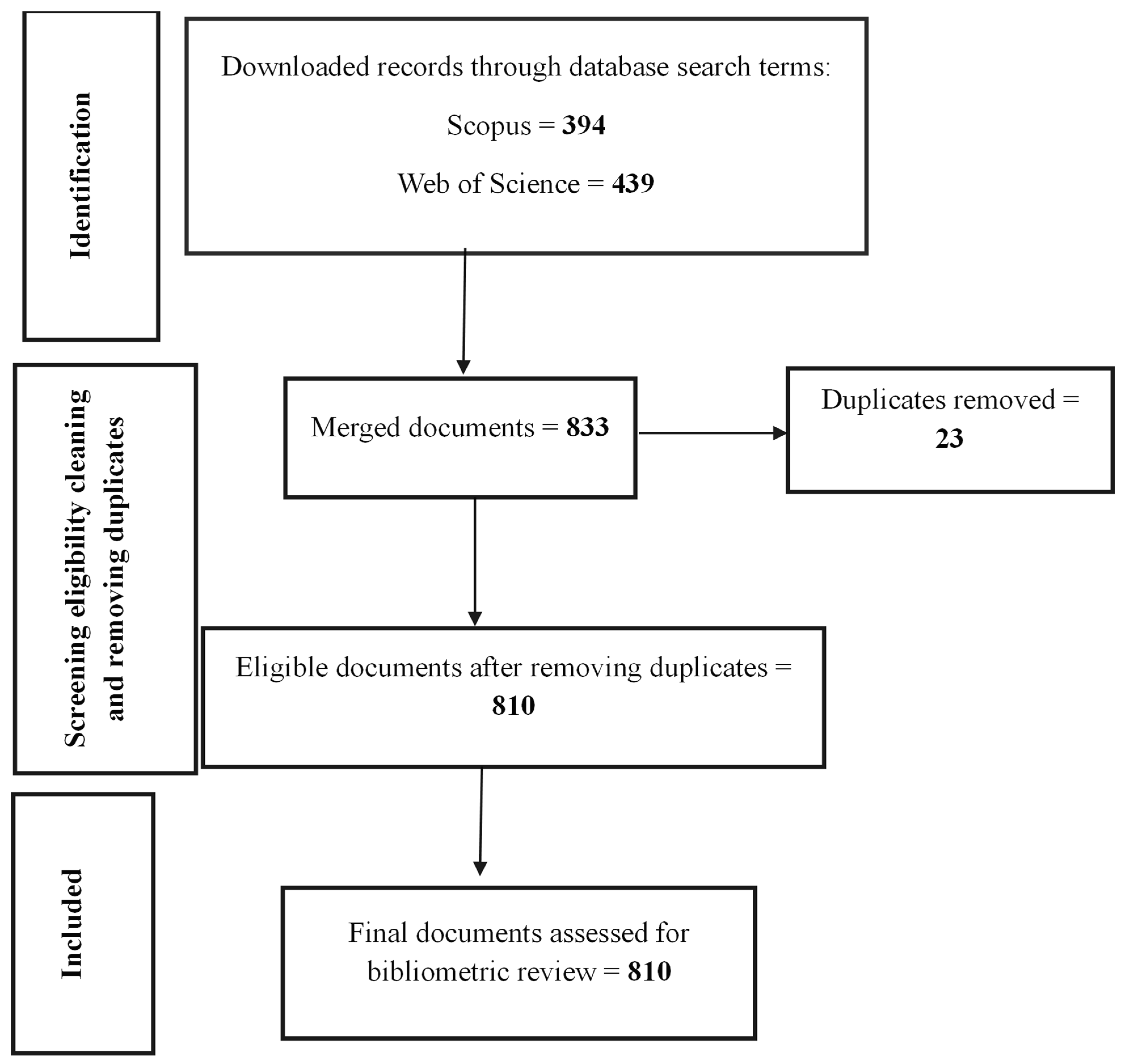
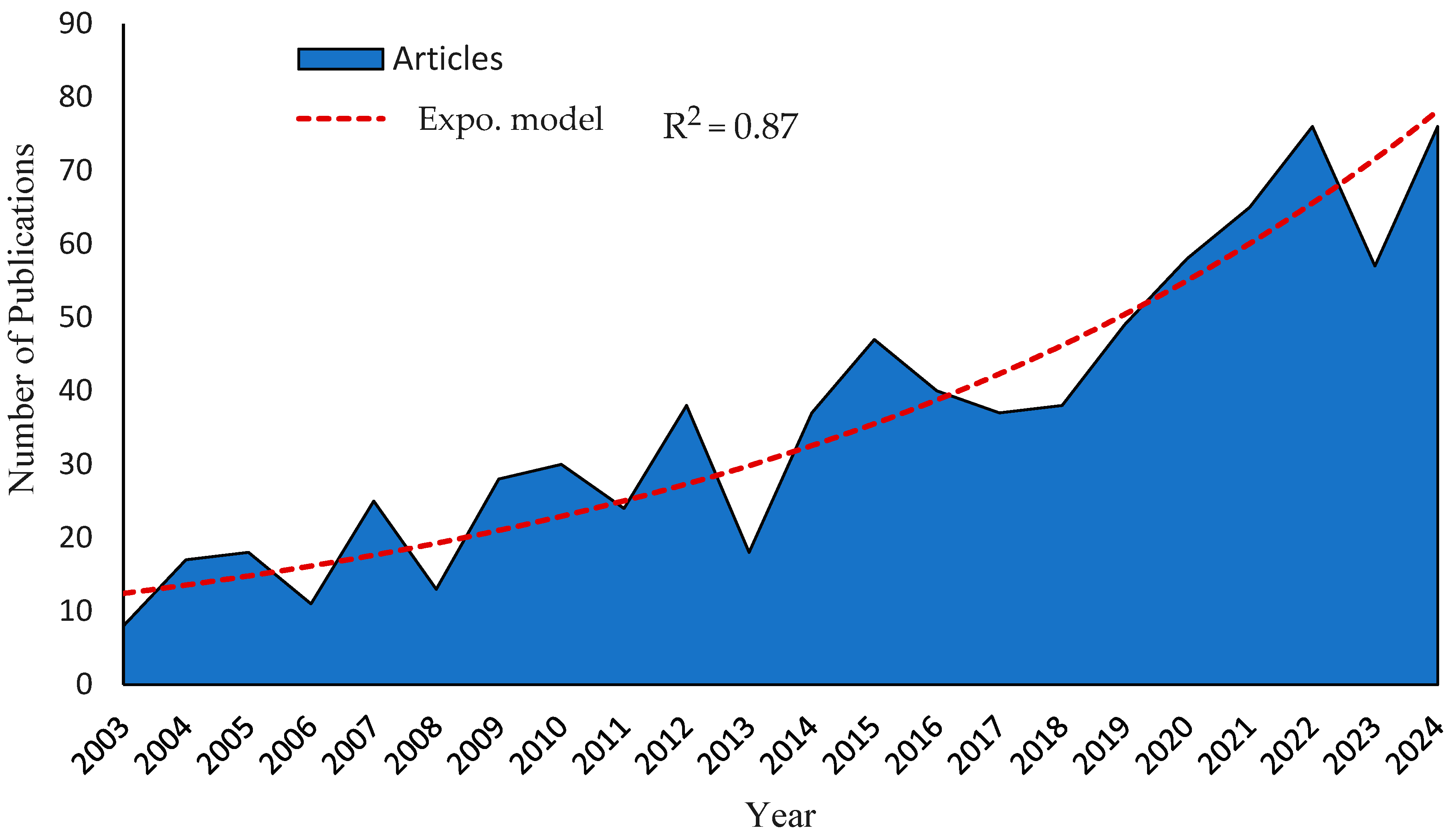
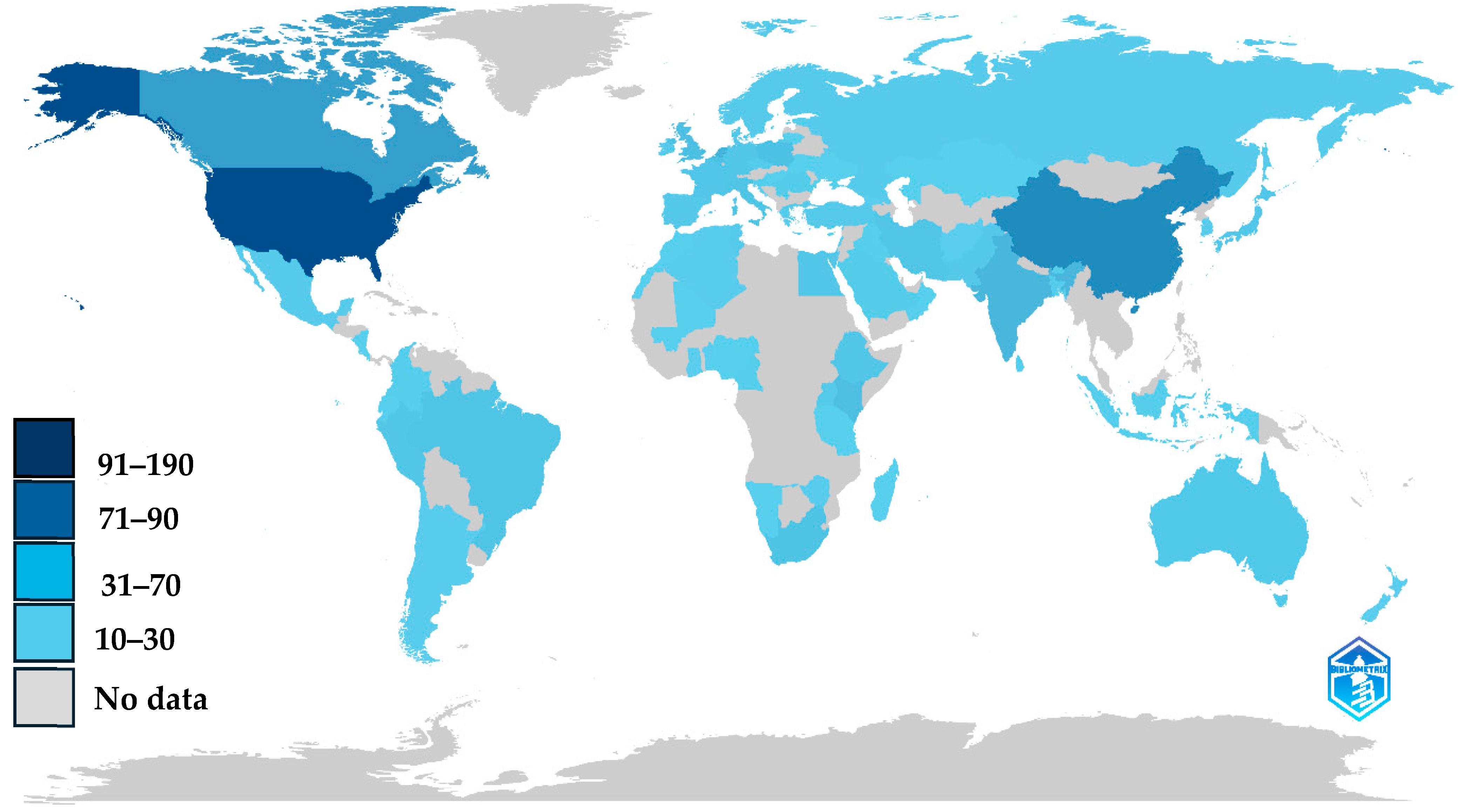
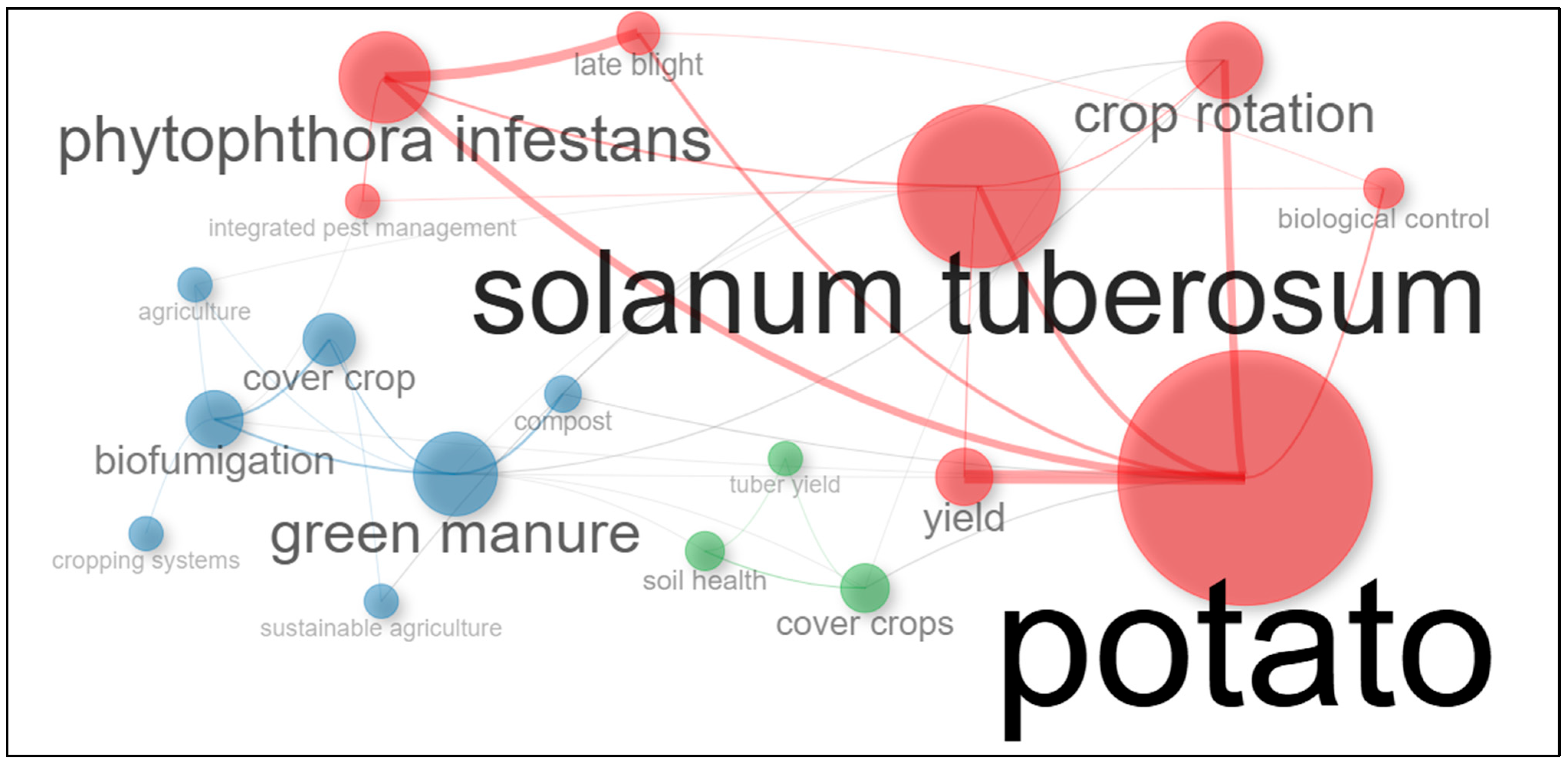
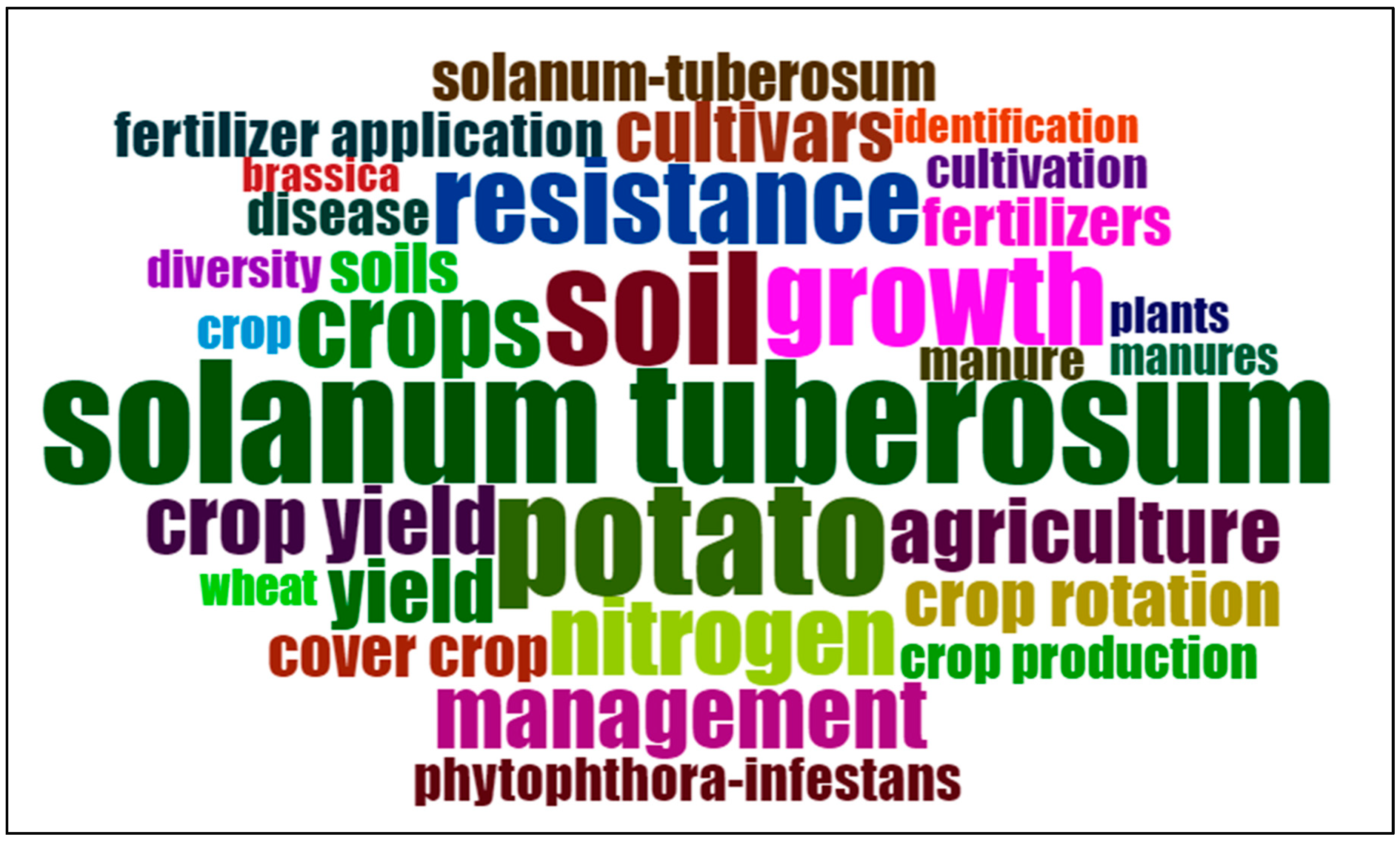
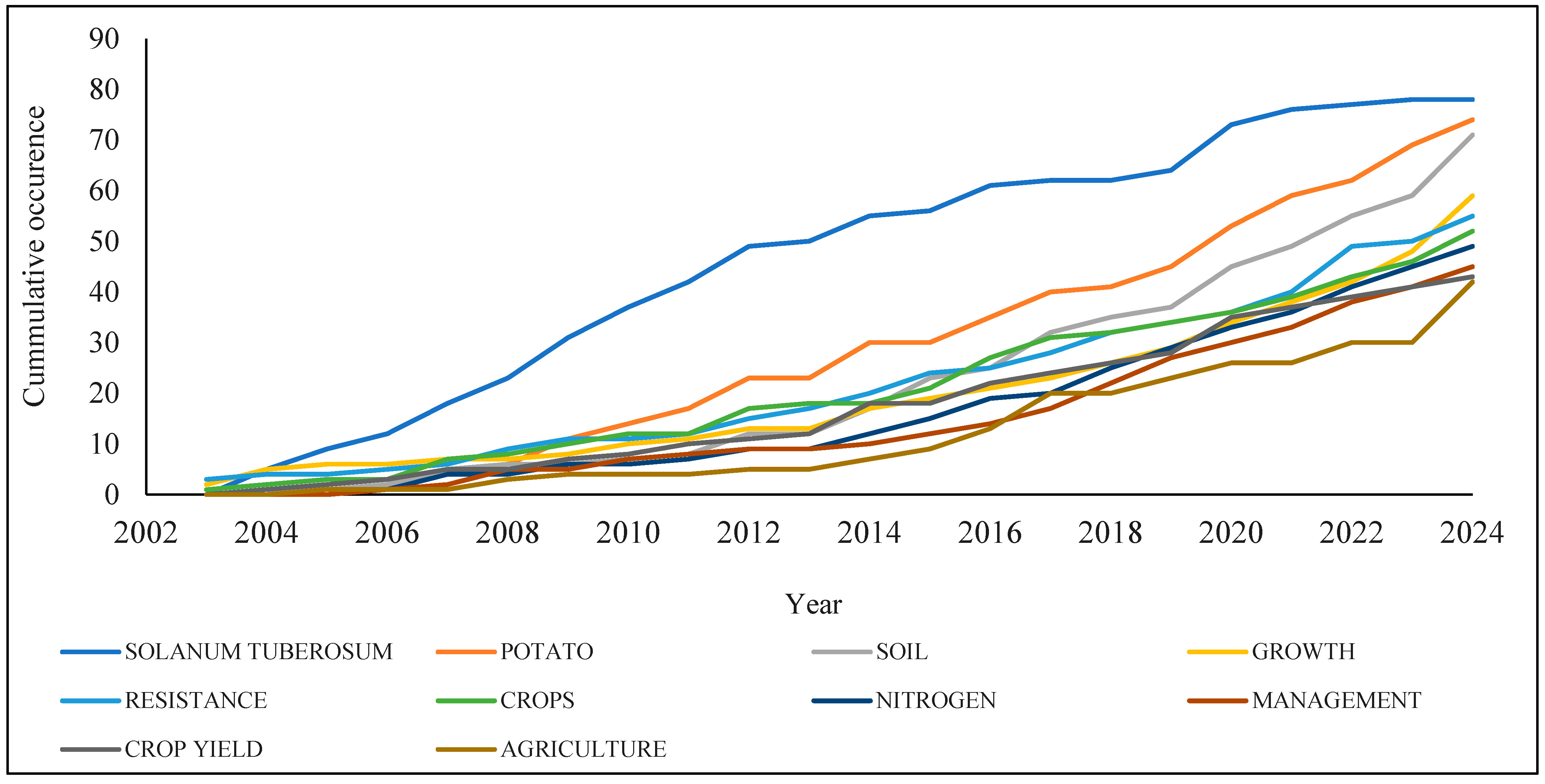
| Country | TCP% | TC | AAC | SCP | MCP |
|---|---|---|---|---|---|
| USA | 23.6 | 8311 | 43.50 | 180 | 11 |
| China | 10.7 | 1626 | 18.70 | 71 | 16 |
| Canada | 8.8 | 1364 | 19.20 | 66 | 5 |
| Netherlands | 3.6 | 1188 | 41.00 | 19 | 10 |
| Brazil | 1.7 | 1116 | 79.70 | 13 | 1 |
| Italy | 2.7 | 947 | 43.00 | 19 | 3 |
| United Kingdom | 2.5 | 943 | 47.10 | 17 | 3 |
| France | 1.6 | 818 | 62.90 | 12 | 1 |
| Japan | 1.2 | 593 | 59.30 | 9 | 1 |
| South Africa | 2 | 487 | 30.40 | 10 | 6 |
| Germany | 1.7 | 386 | 27.60 | 13 | 1 |
| India | 4.1 | 380 | 11.50 | 30 | 3 |
| Kenya | 1.9 | 323 | 21.50 | 9 | 6 |
Disclaimer/Publisher’s Note: The statements, opinions and data contained in all publications are solely those of the individual author(s) and contributor(s) and not of MDPI and/or the editor(s). MDPI and/or the editor(s) disclaim responsibility for any injury to people or property resulting from any ideas, methods, instructions or products referred to in the content. |
© 2025 by the authors. Licensee MDPI, Basel, Switzerland. This article is an open access article distributed under the terms and conditions of the Creative Commons Attribution (CC BY) license (https://creativecommons.org/licenses/by/4.0/).
Share and Cite
Xaba, S.; Bello, Z.; Rapiya, M.; Ngobese, N.Z. Sustainable Nutrient Management Strategies for Enhancing Potato Production: The Role of Cover Crops—A Systematic Review. Horticulturae 2025, 11, 1051. https://doi.org/10.3390/horticulturae11091051
Xaba S, Bello Z, Rapiya M, Ngobese NZ. Sustainable Nutrient Management Strategies for Enhancing Potato Production: The Role of Cover Crops—A Systematic Review. Horticulturae. 2025; 11(9):1051. https://doi.org/10.3390/horticulturae11091051
Chicago/Turabian StyleXaba, Sbonile, Zaid Bello, Monde Rapiya, and Nomali Ziphorah Ngobese. 2025. "Sustainable Nutrient Management Strategies for Enhancing Potato Production: The Role of Cover Crops—A Systematic Review" Horticulturae 11, no. 9: 1051. https://doi.org/10.3390/horticulturae11091051
APA StyleXaba, S., Bello, Z., Rapiya, M., & Ngobese, N. Z. (2025). Sustainable Nutrient Management Strategies for Enhancing Potato Production: The Role of Cover Crops—A Systematic Review. Horticulturae, 11(9), 1051. https://doi.org/10.3390/horticulturae11091051






